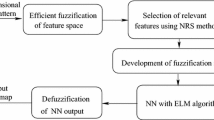In space target recognition using spectral analysis technology, there is the problem that the composition or chemical properties of surface materials of the space target are similar. This problem leads to the high similarity of spectral curves and low accuracy of space target recognition. Similar object recognition is important in the study of actual space target observation. In this paper, an entropy weight fuzzy-rough nearest neighbor (EFRNN) algorithm is proposed to enhance the recognition accuracy of similar space targets, which is an improvement of the fuzzy-rough nearest neighbor algorithm. By introducing the feature weight determined using information entropy, the features of all the training samples are considered and quantified. Moreover, the proposed algorithm combined with fuzzy rough set theory can overcome the fuzzy uncertainty caused by overlapping classes and the rough uncertainty caused by insufficient features, to a certain extent. The simulation results show that the proposed algorithm achieves very promising performance compared with existing algorithms. The EFRNN classifier yields an overall classification accuracy of 95.83%. The proposed algorithm is simple and efficient for similar space target recognition. Furthermore, the EFRNN algorithm does not require preset parameters and complex preprocessing.
Similar content being viewed by others
References
Y. Han, H. Sun, J. Feng, and L. Li, Meas. Sci. Technol., 25, No. 7, 075203 (2014).
Q. Li, K. Wu, and Q. Gao, Spectrosc. Spectral Anal., 36, No. 12, 4067–4071 (2016).
Q. Deng, H. Lu, H. Tao, M. Hu, and F. Zhao , IEEE Access, 7, 28113–28123 (2019).
M. A. A. Cauquya, M. C. Roggemanna, and T. J. Schulz, Proc. SPIE, 5428, 48–57 (2004).
V. P. Pauca, J. Piper, and R. J. Plemmons, Linear Algebra Appl., 416, No. 1, 29–47 (2006).
K. M. Jorgensen, Using Reflectance Spectroscopy to Determine Material Type of Orbital Debris, ProQuest Dissertations, University of Colorado at Boulder, pp. 45–49 (2000).
J. Zhang, Chin. J. Opt. Appl. Opt., 2, No. 1, 10–16 (2009) [In Chinese].
C. Chang and S. Wang, IEEE T. Geosci. Remote., 44, No. 6, 1575–1585 (2006).
R. Duda and P. Hart, Pattern Classification and Scene Analysis, Wiley, New York, pp. 40–41 (1973).
C. Cortes and V. Vapnik, Mach. Learn., 20, 273–297 (1995).
M. Sarkar, Fuzzy Set. Syst., 19, No. 158, 2134–2152 (2007).
A. Onan, Expert Syst. Appl., 42, No. 20, 6844–6852 (2015).
L. Sun and C. Li, In: 2009 WRI Global Congress on Intelligent Systems, May 19–21, Xiamen, China, pp. 311–314 (2009).
J. B. Tenenbaum, V. De. Silva, and J. C. Langford, Science, 290, No. 5500, 2319–2323 (2000).
Author information
Authors and Affiliations
Corresponding author
Additional information
Published in Zhurnal Prikladnoi Spektroskopii, Vol. 87, No. 6, pp. 886–890, November–December, 2020.
Rights and permissions
About this article
Cite this article
Li, Qb., Wei, Y. & Li, Wj. Method for Fine Pattern Recognition of Space Targets Using the Entropy Weight Fuzzy-Rough Nearest Neighbor Algorithm. J Appl Spectrosc 87, 1018–1022 (2021). https://doi.org/10.1007/s10812-021-01103-9
Received:
Published:
Issue Date:
DOI: https://doi.org/10.1007/s10812-021-01103-9




